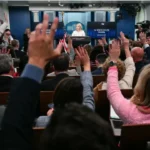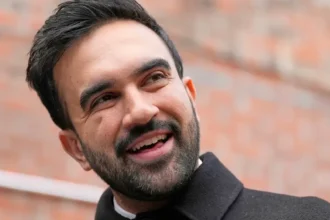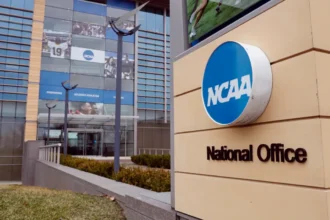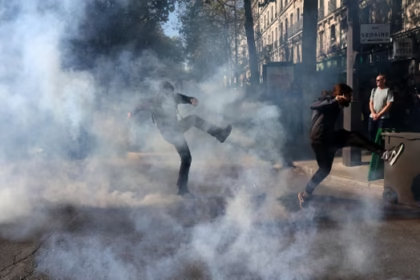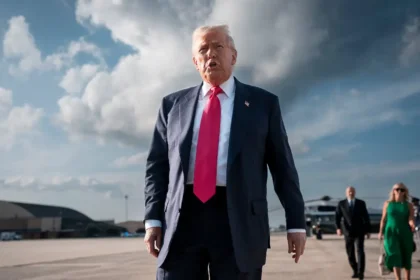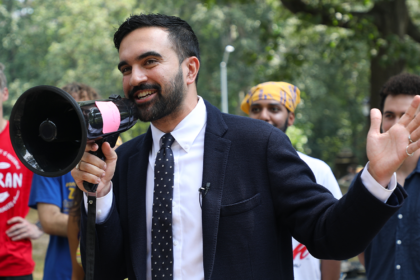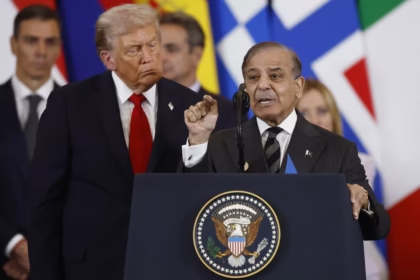Vice President JD Vance turned Halloween into a national talking point after dressing up as a viral meme inspired by himself, sending social media engagement surging past 15 million views and igniting a wave of reactions across the country. What began months ago as a humorous internet trend transforming one of Vance’s well-circulated expressions into a satirical meme has now evolved into a full-scale cultural moment—one that the vice president has chosen not just to acknowledge, but to amplify.
The costume, revealed on his official social media accounts, showed Vice President Vance fully committed to the bit, replicating the original meme with uncanny precision. This included the exaggerated facial expression, the signature posture, and even the background cues that online users had adopted and remixed endlessly. To many Americans, the move signaled a rare, unscripted moment of levity from a top federal figure during an otherwise tense political season, as the administration of President Donald Trump navigates legislative battles, international complexities, and ongoing domestic debates.
According to senior aides, the vice president’s costume was intentionally timed to show a lighter side of an administration often perceived as intensely focused, disciplined, and combative. Advisers said Vance had noticed the meme circulating for months and had joked internally about “owning it” rather than ignoring it. When Halloween approached, the idea gained momentum within his communications team, who recognized its potential to humanize the vice president and strengthen his digital presence among younger voters.
The result exceeded expectations. Within hours of posting, the image had spread across X, Instagram, Facebook, Snapchat, and TikTok, accumulating tens of thousands of comments and millions of engagements. Many users applauded Vance for showing humor and self-awareness, while political analysts noted the increasingly important role digital culture plays in shaping public perception. In today’s political climate—where a meme can influence discussion as much as traditional messaging—Vance’s move was both strategic and culturally relevant.
Supporters celebrated the playful approach, calling it refreshing to see high-ranking officials participate in the culture rather than remain distant from it. “It’s funny, relatable, and smart,” one commenter wrote, capturing a sentiment echoed by thousands. Humor, especially when used intentionally by public officials, can create emotional openness and foster engagement with demographics who typically tune out of political content. The vice president’s team appeared well aware of this dynamic.
Critics, however, were less enthusiastic, arguing that high public office should remain serious at a time of national challenges. Some detractors accused the administration of using a lighthearted moment to distract from political controversies, ongoing debates in Congress, and the continuing government shutdown. Despite these criticisms, analysts argue that such moments rarely shift deeply held political views but can significantly affect digital reach and public relatability, particularly among younger generations.
Inside the White House, officials reportedly viewed the viral surge as a successful example of modernized political communication. President Donald Trump, who has a long and well-documented history of influencing and navigating online culture, was said to have found the stunt amusing and congratulated Vance on the overwhelming response. The president has often emphasized the importance of dominating online conversation, and Vance’s Halloween post demonstrated the administration’s ability to capitalize on cultural trends.
Experts predict the moment will be remembered not as a trivial social media stunt, but as a case study in how future leaders might leverage humor to connect with an evolving electorate. Political communications specialists noted that the boundaries between campaigning, governance, and digital entertainment are becoming increasingly blurred. Moments like Vance’s Halloween reveal show how political figures can merge personal identity with strategic messaging—turning viral humor into a tool of mass engagement.
The episode also underscores how the vice president’s public persona continues to evolve. JD Vance, known early in his political career for serious commentary on culture, class, and national identity, has increasingly adapted to the fast-moving digital environment. The Halloween meme moment highlights his comfort with self-deprecation and his ability to navigate online currents in ways that resonate with both supporters and skeptics.
As the video and images continue circulating, the cultural footprint of Vance’s costume shows no signs of fading. Social media users have already created spin-offs, mashups, Halloween comparison videos, and even AI-generated variations of the original meme. Analysts believe the episode may mark one of the most widely shared non-policy moments of Vance’s vice presidency.
For political observers, the viral Halloween moment offers a glimpse into how the administration of President Donald Trump is increasingly integrating digital culture into its strategy—embracing trends, capitalizing on humor, and ensuring that even lighthearted content reinforces political presence in an age where attention is currency.




